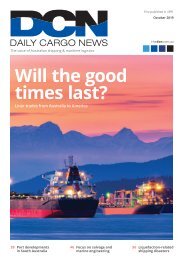DCN May Edition 2019
Create successful ePaper yourself
Turn your PDF publications into a flip-book with our unique Google optimized e-Paper software.
MARITIME LAW<br />
Autonomous ships:<br />
<strong>2019</strong> update and the future<br />
Lawmakers here and overseas have their work cut out as the advent of autonomous<br />
ships gets closer write Michelle Taylor and Stuart Hetherington<br />
REGULATION OF AUTONOMOUS<br />
vessels and legislation dealing with their<br />
safety, manning and operation remain a<br />
particular challenge both nationally and<br />
internationally. The maritime world has<br />
seen a surge of stakeholders take an active<br />
interest in the development and innovation<br />
of autonomous shipping technology. There<br />
is no doubt that autonomous shipping<br />
will continue to develop throughout the<br />
transport industry and across the globe.<br />
Unmanned ships can generally be<br />
categorised according to their level of<br />
automation. In general terms, remotely<br />
operated vessels are controlled and operated<br />
by human operators located onshore in<br />
shore control centres. With completely<br />
autonomous vessels, a human operator<br />
inputs destinations and the vessel will<br />
navigate to these destinations without any<br />
further interaction being required.<br />
IMO AND MASS<br />
In April 2018, the Legal Committee of the<br />
International Maritime Organisation began<br />
a work program for Maritime Autonomous<br />
Stuart Hetherington, partner,<br />
Colin Biggers & Paisley<br />
Surface Ships with a target completion<br />
year of 2020. The aim of the IMO Legal<br />
Committee is to do a gap analysis of<br />
liability and compensation treaties and to<br />
scope the work required for MASS. This<br />
complements the work being done by<br />
the IMO Maritime Safety Committee on<br />
autonomous vessels. The committee has<br />
sought concrete proposals and comments<br />
on a plan of action.<br />
MASS LAW REQUIREMENTS<br />
The IMO Legal Committee work has<br />
been informed by a study of potential<br />
MASS legal requirements done by the<br />
Comite Maritime International, an<br />
international organisation comprising<br />
more than 50 national maritime law<br />
associations. The CMI has analysed eight<br />
IMO conventions: SOLAS (safety at sea),<br />
MARPOL (pollution), COLREG (collision<br />
regulations), STCW (seafarer standards and<br />
training), FAL (facilitation of international<br />
traffic), SAR (search and rescue), SUA<br />
(suppression of unlawful acts in maritime<br />
navigation) and salvage.<br />
DEVELOPMENTS IN UNMANNED<br />
VESSELS<br />
In November 2018 at the CMI Assembly<br />
meeting in London, retired High Court<br />
judge Sir Bernard Eder gave a presentation<br />
entitled Unmanned Vessels: Challenges Ahead.<br />
That presentation noted the following<br />
developments:<br />
• A claim made by Chinese state media<br />
concerning the fastest unmanned<br />
waterborne surface vehicle having a top<br />
speed of over 50 knots.<br />
• A Chinese company that started<br />
building the Wansham Marine Test Field<br />
for testing of autonomous maritime<br />
technology, which is claimed to be the<br />
largest facility of its kind in the world.<br />
• China celebrating the opening of its<br />
Hong Kong - Zhuhai - Macao Bridge<br />
by holding the largest cooperative<br />
Michelle Taylor, partner, Colin Biggers & Paisley<br />
unmanned boat manoeuvre in history<br />
using 81 boats.<br />
• Israel developing an unmanned boat<br />
known as the Katana, an unmanned<br />
surface vehicle.<br />
• Rolls Royce in the UK revealing plans for<br />
an autonomous, single role, naval vessel<br />
with a range of 3500 miles.<br />
• Rolls Royce and Svitzer successfully<br />
demonstrating the world’s first<br />
remotely operated commercial vessel in<br />
Copenhagen, Denmark in 2017.<br />
• The world’s first fully electric and<br />
autonomous cargo ship is being built in<br />
Vard Brevik, Norway, the Yara Birkeland.<br />
AUTONOMOUS SHIPPING CHALLENGES<br />
There are many challenges to consider<br />
with autonomous shipping, particularly<br />
with regulation. The UN Convention on<br />
the Law of the Sea, which is often referred<br />
to as the constitution of the seas, uses<br />
both “ship” and “vessel” interchangeably,<br />
and surprisingly, does not define either.<br />
Sir Bernard Eder has suggested the need<br />
for a “universal term that makes it plain<br />
that the concept of a ship or vessel does<br />
54 <strong>May</strong> <strong>2019</strong><br />
thedcn.com.au
















